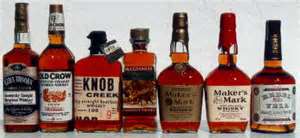 American whiskey is made from a fermented mash of cereal grain. It must consist of at least 51% of a particular grain to be called by the name of the grain (corn whiskey is an exception). It must be distilled to not more than 80% alcohol by volume and the addition of coloring, caramel, and flavorings is not allowed. It must be aged in charred new oak barrels (corn whiskey is an exception). If it is aged two years or more it is additionally designated “straight” as in “straight rye whiskey.” A whiskey that fulfills all these requirements except that it is derived from less than 51% of any one specific grain is called “straight whiskey” without naming a grain.
American whiskey is made from a fermented mash of cereal grain. It must consist of at least 51% of a particular grain to be called by the name of the grain (corn whiskey is an exception). It must be distilled to not more than 80% alcohol by volume and the addition of coloring, caramel, and flavorings is not allowed. It must be aged in charred new oak barrels (corn whiskey is an exception). If it is aged two years or more it is additionally designated “straight” as in “straight rye whiskey.” A whiskey that fulfills all these requirements except that it is derived from less than 51% of any one specific grain is called “straight whiskey” without naming a grain.
Bourbon must be made from at least 51% corn. Nearly all bourbon is aged four years and is made in Kentucky — which has the largest concentration of distilleries on the continent — though the only requirement is that it be made in the US. Common examples are Jim Beam, Makers Mark, and Wild Turkey. Small-batch bourbons are bottled by blending the contents of specially selected barrels. Single-barrel bourbon is from one specifically chosen cask.
Tennessee Whiskey is identical to bourbon in every way except it must be made in Tennessee and filtered through ten feet of sugar-maple charcoal prior to aging (called the Lincoln County Process, named for the original location of the Jack Daniel Distillery). This whiskey variety is not specifically defined in Federal regulations (Title 27 CFR Chapter 1 Subpart C Section 5.22) so is not required to meet any of the Federal codes for bourbon or any other whiskey. It was recognized as a separate American style by the US Government in 1941 in a letter from the US Taxing Authority to the Jack Daniel Distillery. Though permitted to label their products bourbon, Jack Daniel and George Dickel distilleries prefer to designate them as Tennessee Whiskey.
Rye Whiskey must be at least 51% rye. Other ingredients are usually corn and malted barley. Rye was the prevalent whiskey of the northeastern US but largely disappeared after Prohibition. As bourbon gained popularity beyond the southern US, bartenders increasingly substituted it for rye in cocktails like Whiskey Sour, Manhattan, and Old Fashioned. Only a small amount of straight rye whiskey is sold today. Most of it is blended into other whiskeys to give them additional character and structure. Rye is slightly more powerful and spicy than bourbon; cocktails made with rye are drier.
Corn Whiskey must be at least 80% corn. If it is aged it can be for as little as six months and must be in either un-charred barrels or used bourbon barrels.
Wheat Whiskey must be at least 51% wheat and is not common.
Blended Whiskey contains only 20% rye or bourbon whiskey. The remainder is a neutral mass-produced industrial spirit. It is much lighter than other whiskeys, lacks any defining taste characteristics, and is very cheap. The addition of flavorings is allowed in American blends.
_______________
“Too much of anything is bad, but too much of a good whiskey is barely enough.” — Mark Twain
“When it’s third and ten, you can take the milk drinkers and I’ll take the whiskey drinkers every time.” — Max McGee
“Haven’t you learned yet that I put something more than whiskey into my speeches?” — Winston Churchill
